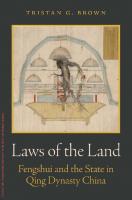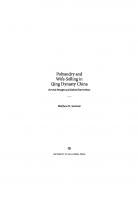Talons and Teeth: County Clerks and Runners in the Qing Dynasty 9780804779951
For commoners in the Qing dynasty, the most salient agents of the imperial state were not the emperor's appointed o
134 50 34MB
English Pages 352 [344] Year 2000
Recommend Papers

- Author / Uploaded
- Bradly W. Reed
File loading please wait...
Citation preview
Talons and Teeth County Clerks and Runners in the Qing Dynasty
Law, Society, and Culture in China EDITORS
Philip C. C. Huang and Kathryn Bernhardt ADVISORY BOARD
William P. Alford, William T Rowe, Hugh Scogin, Jr., Jonathan Spence, Alexander Woodside
T
HE OPENING OF archives on legal case records and judicial administration in China has made possible a new examination of past assumptions about the Chinese justice system. Scholars can now ask where actual legal practice deviated from official and popular conceptualizations and depictions. In the process, they can arrive at a new understanding not only of the legal system, but of state-society relations and the nature of the Chinese social-political system as a whole. Studies of Chinese justice also permit the joining together of social and cultural history. Historians of society and economy, on the one hand, and of mentalities and culture, on the other, have long tended to go their separate ways. Law, however, is a sphere of life in which the two are inseparable. Legal case records contain evidence for both practice and representation. A study of law can tell us about the interconnections between actions and attitudes in ways that segmented studies of each cannot. This series comprises major new studies by the editors themselves, as well as other contributions from a new generation of scholarship, grounded both in the archives and in new theoretical approaches.
Talons and Teeth County Clerks and Runners in the Qing Dynasty
Bradly W. Reed
STANFORD UNIVERSITY PRESS, STANFORD, CALIFORNIA
Stanford University Press Stanford, California © 2000 by the Board of Trustees of the Leland Stanford Junior University Printed in the United States of America CIP data appear at the end of the book
For Ellen and Rachel
Contents
Preface Abbreviations and Conventions
xiii XXl
I
I
Illicit Bureaucrats
2
Clerks
3I
3
Families, Friends, and Factions
76
4
Runners
I22
5
Illicit Allies and the Magistrate's Men
I6o
6
The Economics of Justice
200
7
The Legitimacy of the Indispensable
246
Appendixes Administrative Duties of Clerical Offices in the Ba County Yamen
269
B
The Jins of Ba County
27I
c
Clerical Agreement on Mutual Support and the Dispensation of Legal Case Assignments
273
D
Case Fees and Three Fees Regulations
276
E
Division of Case Jurisdiction
280
F
District Runner Agreement on the Division of Cases
28I
A
Contents
X
Notes Works Cited Character List Index
287
299 307 313
Tables and Illustrations
Tables I 2
Number of Clerks in the Ba County Yamen by Office, I878-I908
48
Running Fee Payment Schedule for Successive Salt Office Head Clerks
89
3
Personal Affiliations in the Office of Works, ca. 1894
108
4
Statutory Quotas for Runners in Ba County
I46
5
Extrastatutory Runners in Ba County
I48
6
Landholdings of Statutory Ba County Runners, I86I
I 53
Figures I
Number of Registered Clerks in the Ba County Yamen, r8y8-I908
46
2
Number of Registered Clerks in the Ba County Yamen by Office, I878-I908
3
Organization of Ba County District Runners
I26
Sichuan Province During the Qing Dynasty, with Ba County Highlighted
xxvi
49
Map
Preface
A
A GRADUATE STUDENT, l was initially drawn to county clerks and runners in Qing dynasty China by my discovery of how little anyone actually seemed to know about them. True, they were mentioned in nearly all the scholarly works on local government during the Qing, but only rarely did these citations extend beyond a brief, caricatured description of an undifferentiated mass of corrupt ne'er-do-wells, single-mindedly bent on the pursuit of their own self-interest. Despite the fact that clerks and runners carried out most of the administrative work in the county yamen, there was little or no information available as to who these people actually were, where they came from, how they were organized, or how they went about performing their work in the yamen. The dissertation upon which this book is based began as an attempt to redress this situation. My intent was to get past the simplified representations of clerks and runners as stock villains in order to better understand their role in county government and the part their actions might have played in the relationship between the Qing state and local communities. In the process I wanted to traverse the distance between the statutory norms dictated by the central government in Beijing and daily administrative practice at the local level in order to discover how a local yamen actually operated. I subsequently determined that the best way to accomplish this task was not to provide a comprehensive sketch of county yamens throughout the empire, but rather to render a more detailed account of a single yamen. Before I could begin, however, I first had to confront the problem of sources. Previous studies of local administration under the Qing
xiv
Preface
have drawn almost exclusively from three bodies of documentation: county and provincial gazetteers written under the auspices of either the government or local gentryi the collected writings of various officials in the form of handbooks and memoirsi and compendiums of central-level documents including edicts, memorials, and administrative regulations. While these sources are adequate for descriptions of formal structure and official policy, they are of considerably less value in revealing the minutiae of quotidian practice in the yamen. To reach that level of detail, it would be necessary to delve into county government archives. Until quite re

![A Pictorial Record of the Qing Dynasty - Qing Dynasty Architecture [1st ed.]
981427240X, 9789814272407](https://ebin.pub/img/200x200/a-pictorial-record-of-the-qing-dynasty-qing-dynasty-architecture-1stnbsped-981427240x-9789814272407.jpg)







